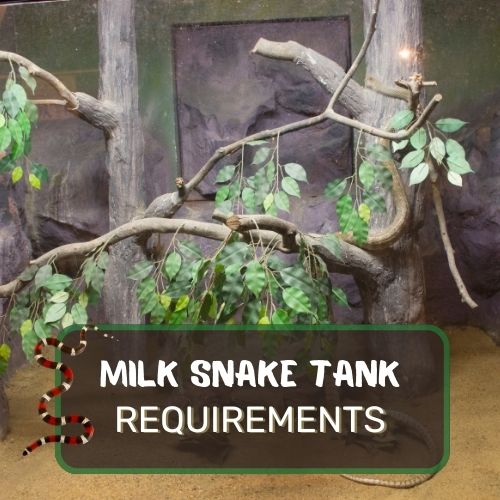Diving into the mesmerizing world of baby milk snakes? You’re in for a delightful journey! These vibrant reptiles have dietary preferences and needs that are as unique as their stunning patterns.
Baby milk snakes primarily eat pinky mice in captivity. In the wild, their diet includes small rodents, tiny birds, amphibians, and insects. As they grow, their dietary needs change, shifting to larger prey. It’s essential to replicate their natural diet for optimal health and growth.
This comprehensive guide explores the optimal diets for captive baby milk snakes, contrasting it with their wild counterparts. We’ll delve into the essential foods, the no-nos, and even the how-tos of feeding.
Plus, as they grow, their diet needs change—so we’ve got that covered too! Top it off with answers to frequently asked questions, and you’re set to ensure your serpentine friend thrives.
Let’s slither into the details, shall we?

Table of Contents
Optimal Diet for Captive Baby Milk Snakes
Alright, let’s get into it! If you’ve recently taken in a baby milk snake or you’re just plain curious about their culinary preferences, you’re in the right spot.
Baby milk snakes have a set of dietary needs that are absolutely crucial for their health and longevity. So, let’s dissect this tasty topic, shall we?
Importance of Replicating Their Wild Diet
Baby milk snakes, like all creatures, have evolved to thrive best on the food they’d naturally encounter in the wild. Nature, in her wisdom, has finely tuned these serpents’ dietary needs.
By mirroring this wild diet as closely as possible, we’re ensuring they get the right nutrients in the right proportions.
Imagine if someone tried to make you eat nothing but, let’s say, cheeseburgers every day (however tempting that might sound). It wouldn’t be long before you started missing the essential nutrients from veggies, fruits, and other food groups.
Similarly, neglecting the baby snake’s nutrition can lead to health issues down the line.
Preferred Food Items for Those in Captivity
Now, the million-dollar question: “What’s on the menu?” For baby milk snakes in captivity, their taste buds (or the snakey equivalent of taste buds) lean towards a diet of:
- Pinky mice
- Small lizards
- Small amphibians
These are essentially the starter meals for our little snake buddies. As they grow and transition through the milk snake growth stages, their prey preference and size will change. It’s essential to adjust their diet accordingly.
The Role of Variety in Their Diet
Variety is the spice of life, and baby milk snakes are no different. In the wild, these reptiles don’t get to eat the same type of prey every single time. Sometimes it might be a lizard; other times, it’s a tender amphibian.
By introducing a varied diet, not only do you mimic their natural feeding habits, but you also prevent dietary deficiencies and enrich their life. Think of it as rotating between sushi, pizza, and tacos instead of sticking to just one. Sounds delightful, right?
How Often to Feed Them
Baby milk snakes are constantly growing, which means they have a pretty hearty appetite. Typically, feeding them once every 5 to 7 days is a good rule of thumb. However, it’s essential to observe them.
If your slithery friend isn’t showing interest in food, don’t force it. It might be going through a shedding phase or just isn’t hungry.
On the other hand, if they seem to be constantly on the hunt for more, you might want to consult with a reptile expert to ensure you’re meeting their needs.

Natural Diet of Baby Milk Snakes in the Wild
Let’s uncover the secrets of what baby milk snakes feast on when they’re out in their natural habitats.
An Insight into Their Natural Environment
Milk snakes dwell in various environments—be it forests, grasslands, or rocky areas. The place they call home often plays a pivotal role in determining their diet.
For instance, a baby milk snake found in a dense forest might have a slightly different menu than its cousin residing in grassy plains.
Common Prey Items They Love Munching On
Out in the wild, baby milk snakes have a buffet of choices. They are primarily known to snack on:
- Small rodents, especially newborns
- Little birds and their eggs
- Amphibians like frogs
- Insects and other tiny critters
Remember, these are just the popular items. Depending on where they reside, there might be other delicacies they stumble upon!
Frequency of Their Meals in the Wild
Now, unlike the predictability of captivity, meals in the wild aren’t on a set schedule. Sometimes, they might snag a meal every couple of days, while at other times, they could go a week or more without dining.
Factors like prey availability, climate, and even the snake’s recent growth can influence these feeding patterns.

Safe and Unsafe Foods: A Detailed Guide
Now that we’ve had a peek into their wild diet let’s dive into the nitty-gritty of what’s good and what’s a big no-no for our baby milk snakes.
The Absolute Must-Haves for Their Menu
The ideal diet for a captive baby milk snake, as mentioned earlier, includes pinky mice, small lizards, and amphibians. These are nutrient-rich and mirror what they’d naturally eat. Keeping this variety ensures they’re getting all the essential vitamins and minerals.
Foods That Are Harmful or Fatal
Now, here’s where we need to tread with caution. Foods to definitely avoid are:
- Anything larger than the snake’s girth (can lead to choking or digestive problems)
- Prey with sharp bones or spines
- Insects treated with pesticides or from unknown sources
Common Misconceptions about Baby Milk Snake Diet
“Can I feed them fish?” “How about a slice of ham?” Questions like these pop up due to misconceptions. While they might seem harmless, sticking to their natural diet is the way to go. They don’t need processed or human foods.
And no, a little treat outside their dietary needs isn’t “fun” for them.
Signs of an Unhealthy Diet
Your snake’s behavior and physical appearance can be great indicators of its health. Watch out for:
- Lack of appetite or refusing to eat
- Regurgitation after meals
- Dull, patchy, or dry skin
- Lethargy or unusual aggression
Remember, any sudden or prolonged changes should have you consulting with a reptile specialist. It’s always better to be safe than sorry!
We’ve navigated the ins and outs of baby milk snake diets from their wild escapades to ensuring their captive meals are top-notch. Feed ’em right, and they’ll slither happily into a healthy life!

How to Feed Your Baby Milk Snake: A Step-by-Step Process
Feeding time is an essential ritual for your baby milk snake, and it’s not just about what you feed them, but also how you do it. Want to become a pro at this? Let’s get the ball (or should I say, snake?) rolling!
Setting up the Right Environment for Feeding
First things first, environment matters. If you’re using a separate feeding container (which some experts recommend to avoid substrate ingestion), ensure it’s escape-proof and comfortable.
Warm it up slightly before placing your snake inside. If you’re feeding in their main enclosure, ensure it’s calm and free from disturbances.
The Ideal Feeding Schedule
While baby milk snakes are generally fed once every 5 to 7 days, it’s essential to set a consistent schedule, especially when they’re younger.
Mark your calendar, set a reminder, or maybe even use an old-fashioned alarm clock. Whatever it takes to stick to that routine!
Monitoring the Snake’s Reaction Post-Feeding
After the meal, observe your snake. Check for any signs of distress, like constant yawning (a potential sign of an oversized meal) or regurgitation.
If all seems well, give them some quiet time to digest. Remember, post-meal is when they’re most vulnerable, so minimize handling during this period.

Transitioning Diet as the Milk Snake Grows
Growth isn’t just about getting longer or heavier; it’s also about the evolving dietary needs of your milk snake. Let’s unravel the mystery of changing their diet as they mature.
Changes in Dietary Needs as They Mature
As your baby milk snake grows, so will its appetite. While pinky mice might be the go-to for juveniles, an adult milk snake will require larger prey, such as fuzzies or even full-grown mice.
The menu might also expand to include larger amphibians or even small birds.
Gradually Introducing New Food Items
Imagine diving into a new cuisine without any heads up—sounds daunting, right? The same goes for snakes. When introducing new prey items, do so gradually.
Maybe offer a combination of familiar and new prey initially, and observe their reaction. Adjust based on their preference.
Adjusting Feeding Frequency
With growth comes a change in metabolism. As milk snakes mature, their feeding frequency might decrease. Instead of the weekly meals they enjoyed as youngsters, adult milk snakes might only require a meal every 10-14 days.
However, always be attentive to their cues. If they seem more active or hunt frequently, it might be a sign to adjust the feeding days.
And there you have it—a complete journey from baby steps to mature strides in the world of milk snake diets. By staying informed and observant, you ensure your snake enjoys a diet as vibrant and dynamic as its beautiful skin patterns!
Final Word
You’ve journeyed through the intricate dietary world of baby milk snakes, grasping the nuances of their captive and wild diets. Understanding what these captivating creatures eat, from pinky mice to amphibians, is paramount for their well-being.
As they grow, so do their dietary needs, and now you’re equipped with that knowledge. Remember, a well-fed milk snake is a happy and healthy one.
As you venture into snake-keeping or deepen your existing bond, take pride in offering the best to your slithery companion. You’ve got this!
FAQ
Let’s dive into some of the most burning questions about baby milk snake care.
How do you take care of a baby milk snake?
Caring for a baby milk snake involves providing a suitable habitat with a regulated temperature, hiding spots, and a clean substrate. Ensure they have access to fresh water and are fed a nutritious diet based on their age and size. Regularly clean their enclosure and monitor their health.
What do you feed a newborn milk snake?
A newborn milk snake’s menu primarily consists of pinky mice. If they’re hesitant at first, scenting the mouse with a lizard or frog can entice them. Some baby milk snakes also take to small lizards or amphibians.
How often do you feed a baby milk snake?
Typically, it’s best to feed a baby milk snake once every 5 to 7 days. Their metabolism is pretty high, so they need frequent meals to support their growth.
How long can a baby milk snake go without eating?
While baby milk snakes have a hearty appetite, there might be times (like during shedding) when they refuse food. Generally, they can go up to two weeks without eating, but if they refuse food consistently, it’s essential to consult a vet or a reptile expert.




0 Comments